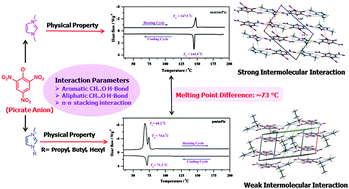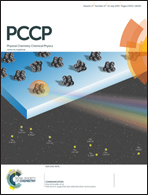Significance of weak interactions in imidazolium picrate ionic liquids: spectroscopic and theoretical studies for molecular level understanding†
Abstract
The effects of interionic hydrogen bonding and π–π stacking interactions on the physical properties of a new series of picrate anion based ionic liquids (ILs) have been investigated experimentally and theoretically. The existence of aromatic (C2–H⋯O) and aliphatic (C7–H⋯O–N22 and C6–H⋯O–N20) hydrogen bonding and π–π stacking interactions in these ILs has been observed using various spectroscopic techniques. The aromatic and aliphatic C–H⋯O hydrogen bonding interactions are found to have a crucial role in binding the imidazolium cation and picrate anion together. However, the π–π stacking interactions between two successive layers are found to play a decisive role in tight packing in ILs leading to differences in physical properties. The drastic difference in the melting points of the methyl and propyl derivatives (mmimPic and pmimPic respectively) have been found to be primarily due to the difference in the strength and varieties of π–π stacking interactions. While in mmimPic, several different types of π–π stacking interactions between the aromatic rings (such as picrate–picrate, picrate–imidazole and imidazolium–imidazolium cation rings) are observed, only one type of π–π stacking interaction (picrate–picrate rings) is found to exist in the pmimPic IL. NMR spectroscopic studies reveal that the interaction of these ILs with solvent molecules is different and depends on the dielectric constant of the solvent. While an ion solvation model explains the solvation in high dielectric solvents, an ion-pair solvation model is found to be more appropriate for low dielectric constant solvents. The enhanced stability of these investigated picrate ILs compared with that of inorganic picrate salts under high doses of γ radiation clearly indicates the importance of weak interionic interactions in ILs, and also opens up the possibility of the application of picrate ILs as prospective diluents in nuclear separation for advanced fuel cycling process.


 Please wait while we load your content...
Please wait while we load your content...